Murdoch University BSC203: Literature Review on Mobile Analytics
VerifiedAdded on 2023/01/18
|10
|2497
|70
Literature Review
AI Summary
This literature review examines the current state of mobile analytics, drawing on ten articles to explore key concepts and trends. The review covers a range of topics, including the use of deep learning and hybrid architectures for privacy-preserving analytics, big data analytics, and the role of mobile learning. It analyzes the efficiency of mobile analytics, addressing challenges related to computational power, storage, and battery life in mobile devices. The review also discusses the application of big data analytics in mobile cellular networks, the use of Spark-based systems for deep model analysis, and the potential of learning analytics for self-regulated learning. Furthermore, it explores the use of structural models for mobile application analytics, location-based data analytics, and the implementation of differential privacy for software analytics in mobile applications. Finally, the review considers the role of mobile network planning tools and the categories of mobile analytics for achieving user behavior visibility, concluding with the potential for mobile advertising and marketing.
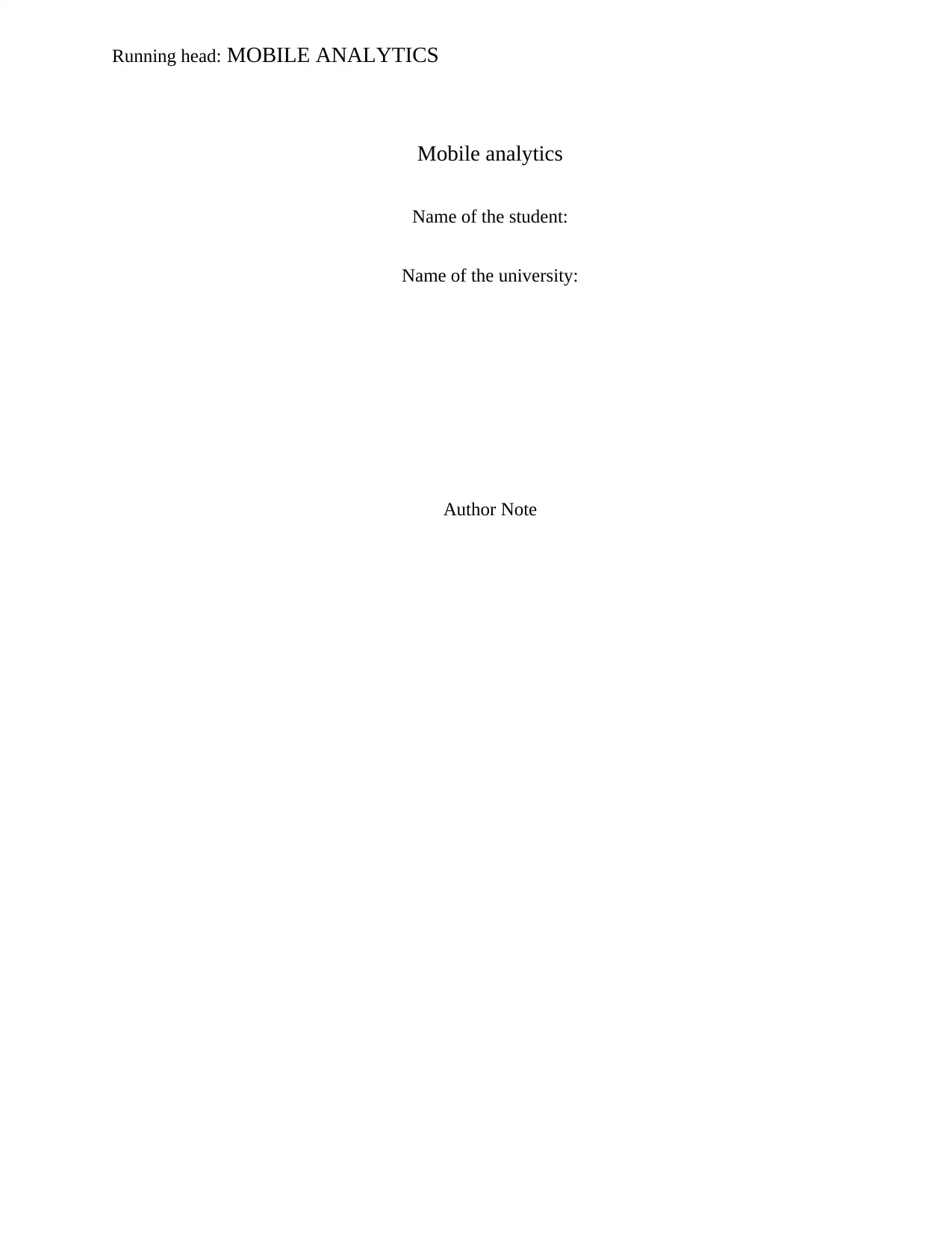
Running head: MOBILE ANALYTICS
Mobile analytics
Name of the student:
Name of the university:
Author Note
Mobile analytics
Name of the student:
Name of the university:
Author Note
Paraphrase This Document
Need a fresh take? Get an instant paraphrase of this document with our AI Paraphraser
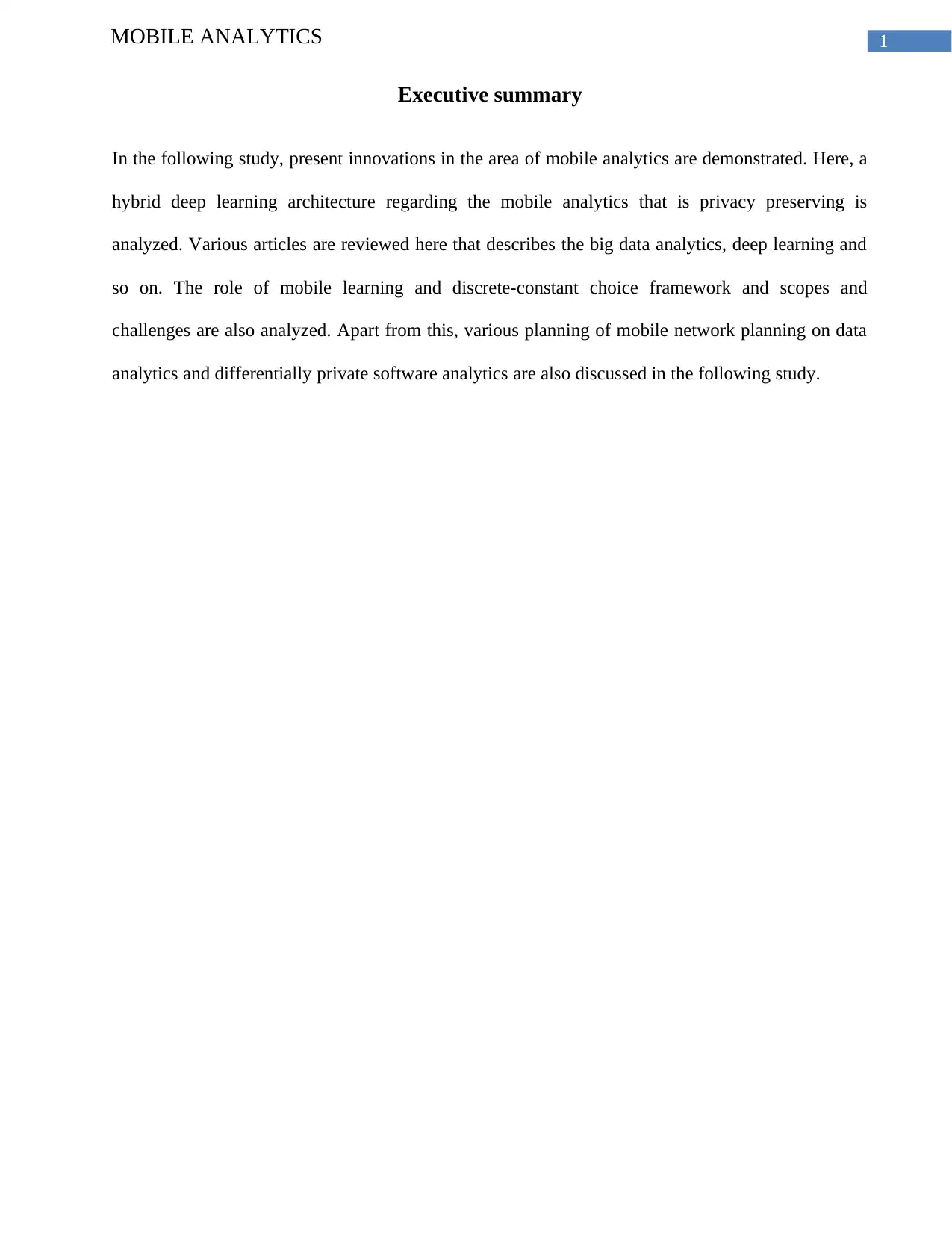
1MOBILE ANALYTICS
Executive summary
In the following study, present innovations in the area of mobile analytics are demonstrated. Here, a
hybrid deep learning architecture regarding the mobile analytics that is privacy preserving is
analyzed. Various articles are reviewed here that describes the big data analytics, deep learning and
so on. The role of mobile learning and discrete-constant choice framework and scopes and
challenges are also analyzed. Apart from this, various planning of mobile network planning on data
analytics and differentially private software analytics are also discussed in the following study.
Executive summary
In the following study, present innovations in the area of mobile analytics are demonstrated. Here, a
hybrid deep learning architecture regarding the mobile analytics that is privacy preserving is
analyzed. Various articles are reviewed here that describes the big data analytics, deep learning and
so on. The role of mobile learning and discrete-constant choice framework and scopes and
challenges are also analyzed. Apart from this, various planning of mobile network planning on data
analytics and differentially private software analytics are also discussed in the following study.
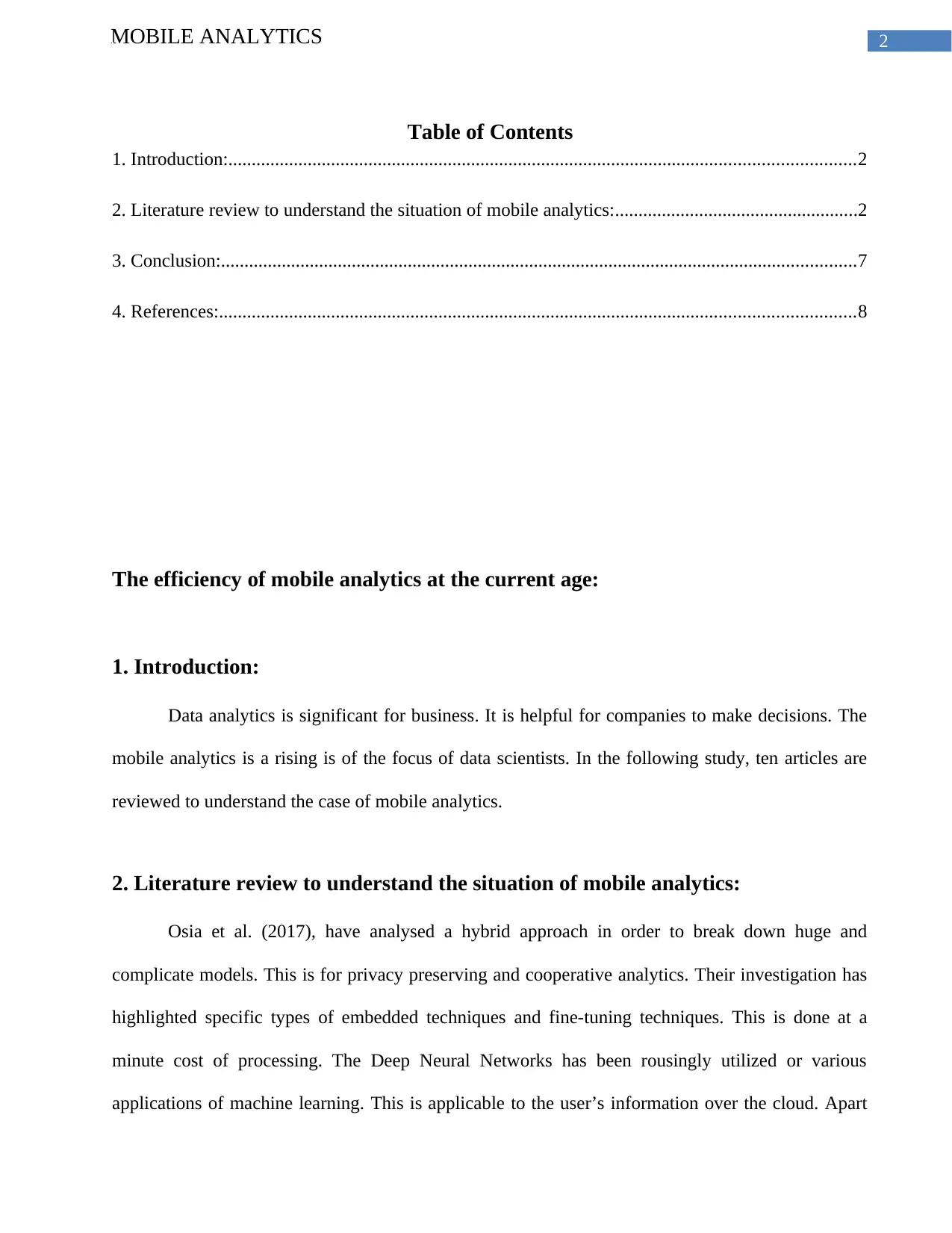
2MOBILE ANALYTICS
Table of Contents
1. Introduction:......................................................................................................................................2
2. Literature review to understand the situation of mobile analytics:....................................................2
3. Conclusion:........................................................................................................................................7
4. References:........................................................................................................................................8
The efficiency of mobile analytics at the current age:
1. Introduction:
Data analytics is significant for business. It is helpful for companies to make decisions. The
mobile analytics is a rising is of the focus of data scientists. In the following study, ten articles are
reviewed to understand the case of mobile analytics.
2. Literature review to understand the situation of mobile analytics:
Osia et al. (2017), have analysed a hybrid approach in order to break down huge and
complicate models. This is for privacy preserving and cooperative analytics. Their investigation has
highlighted specific types of embedded techniques and fine-tuning techniques. This is done at a
minute cost of processing. The Deep Neural Networks has been rousingly utilized or various
applications of machine learning. This is applicable to the user’s information over the cloud. Apart
Table of Contents
1. Introduction:......................................................................................................................................2
2. Literature review to understand the situation of mobile analytics:....................................................2
3. Conclusion:........................................................................................................................................7
4. References:........................................................................................................................................8
The efficiency of mobile analytics at the current age:
1. Introduction:
Data analytics is significant for business. It is helpful for companies to make decisions. The
mobile analytics is a rising is of the focus of data scientists. In the following study, ten articles are
reviewed to understand the case of mobile analytics.
2. Literature review to understand the situation of mobile analytics:
Osia et al. (2017), have analysed a hybrid approach in order to break down huge and
complicate models. This is for privacy preserving and cooperative analytics. Their investigation has
highlighted specific types of embedded techniques and fine-tuning techniques. This is done at a
minute cost of processing. The Deep Neural Networks has been rousingly utilized or various
applications of machine learning. This is applicable to the user’s information over the cloud. Apart
⊘ This is a preview!⊘
Do you want full access?
Subscribe today to unlock all pages.

Trusted by 1+ million students worldwide
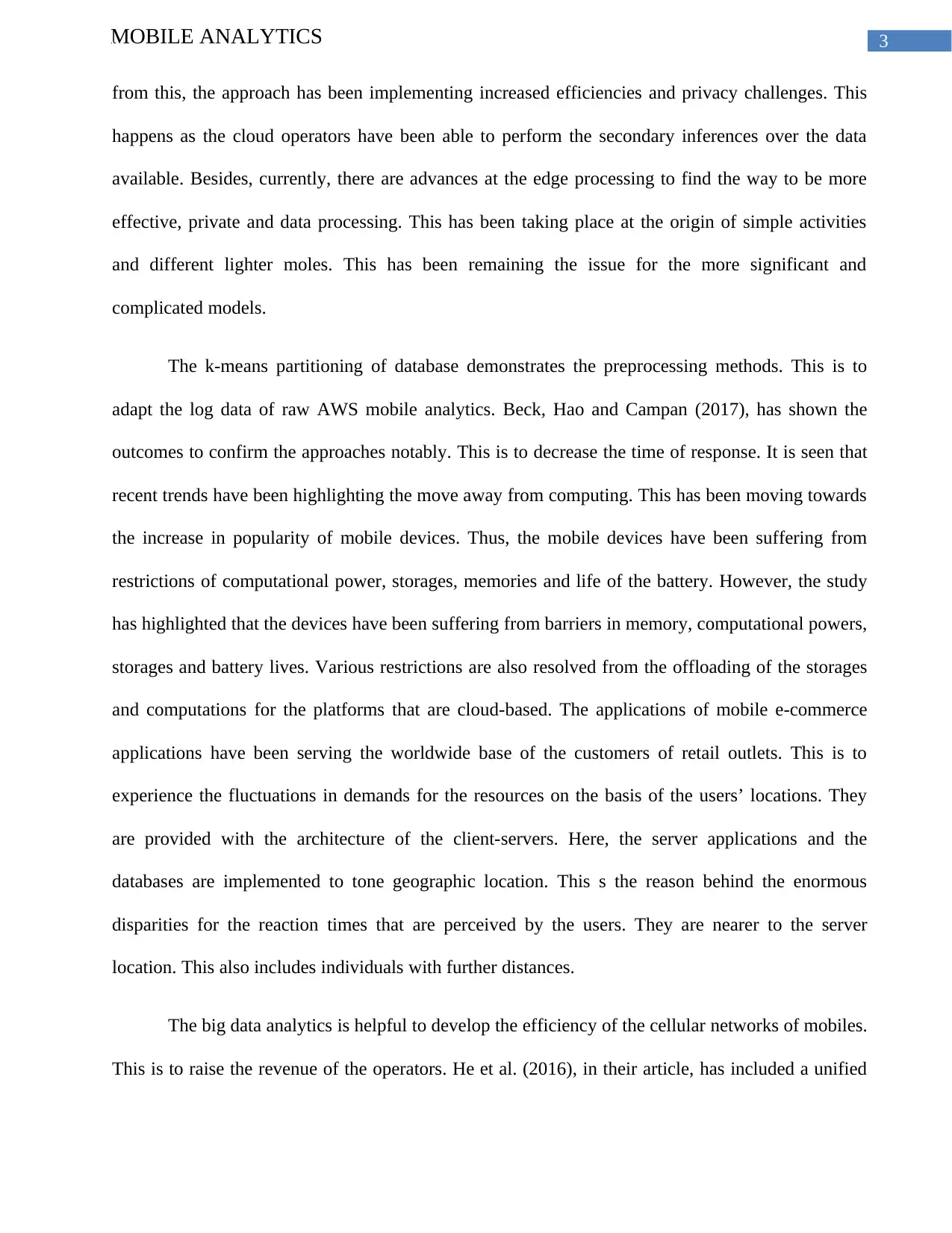
3MOBILE ANALYTICS
from this, the approach has been implementing increased efficiencies and privacy challenges. This
happens as the cloud operators have been able to perform the secondary inferences over the data
available. Besides, currently, there are advances at the edge processing to find the way to be more
effective, private and data processing. This has been taking place at the origin of simple activities
and different lighter moles. This has been remaining the issue for the more significant and
complicated models.
The k-means partitioning of database demonstrates the preprocessing methods. This is to
adapt the log data of raw AWS mobile analytics. Beck, Hao and Campan (2017), has shown the
outcomes to confirm the approaches notably. This is to decrease the time of response. It is seen that
recent trends have been highlighting the move away from computing. This has been moving towards
the increase in popularity of mobile devices. Thus, the mobile devices have been suffering from
restrictions of computational power, storages, memories and life of the battery. However, the study
has highlighted that the devices have been suffering from barriers in memory, computational powers,
storages and battery lives. Various restrictions are also resolved from the offloading of the storages
and computations for the platforms that are cloud-based. The applications of mobile e-commerce
applications have been serving the worldwide base of the customers of retail outlets. This is to
experience the fluctuations in demands for the resources on the basis of the users’ locations. They
are provided with the architecture of the client-servers. Here, the server applications and the
databases are implemented to tone geographic location. This s the reason behind the enormous
disparities for the reaction times that are perceived by the users. They are nearer to the server
location. This also includes individuals with further distances.
The big data analytics is helpful to develop the efficiency of the cellular networks of mobiles.
This is to raise the revenue of the operators. He et al. (2016), in their article, has included a unified
from this, the approach has been implementing increased efficiencies and privacy challenges. This
happens as the cloud operators have been able to perform the secondary inferences over the data
available. Besides, currently, there are advances at the edge processing to find the way to be more
effective, private and data processing. This has been taking place at the origin of simple activities
and different lighter moles. This has been remaining the issue for the more significant and
complicated models.
The k-means partitioning of database demonstrates the preprocessing methods. This is to
adapt the log data of raw AWS mobile analytics. Beck, Hao and Campan (2017), has shown the
outcomes to confirm the approaches notably. This is to decrease the time of response. It is seen that
recent trends have been highlighting the move away from computing. This has been moving towards
the increase in popularity of mobile devices. Thus, the mobile devices have been suffering from
restrictions of computational power, storages, memories and life of the battery. However, the study
has highlighted that the devices have been suffering from barriers in memory, computational powers,
storages and battery lives. Various restrictions are also resolved from the offloading of the storages
and computations for the platforms that are cloud-based. The applications of mobile e-commerce
applications have been serving the worldwide base of the customers of retail outlets. This is to
experience the fluctuations in demands for the resources on the basis of the users’ locations. They
are provided with the architecture of the client-servers. Here, the server applications and the
databases are implemented to tone geographic location. This s the reason behind the enormous
disparities for the reaction times that are perceived by the users. They are nearer to the server
location. This also includes individuals with further distances.
The big data analytics is helpful to develop the efficiency of the cellular networks of mobiles.
This is to raise the revenue of the operators. He et al. (2016), in their article, has included a unified
Paraphrase This Document
Need a fresh take? Get an instant paraphrase of this document with our AI Paraphraser
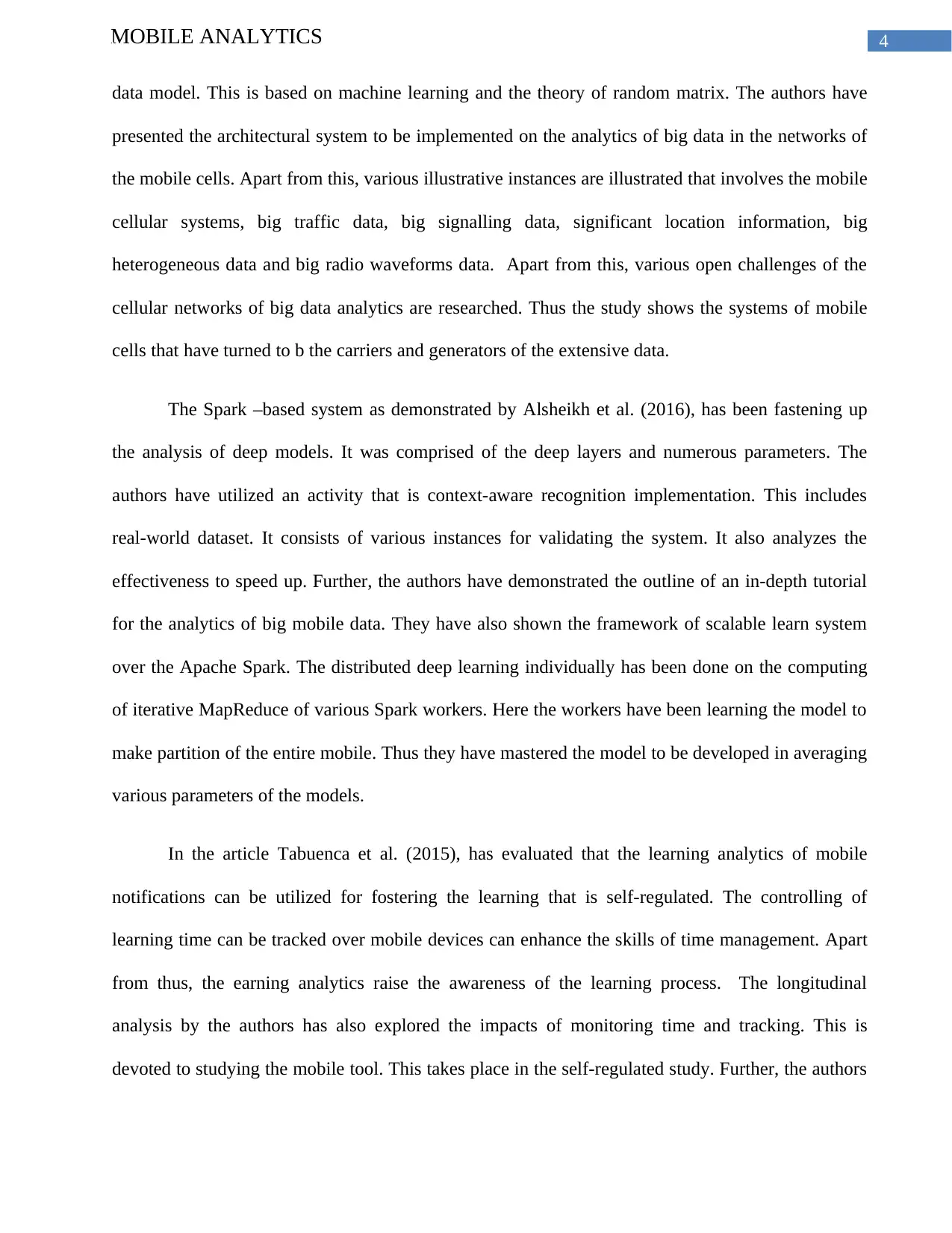
4MOBILE ANALYTICS
data model. This is based on machine learning and the theory of random matrix. The authors have
presented the architectural system to be implemented on the analytics of big data in the networks of
the mobile cells. Apart from this, various illustrative instances are illustrated that involves the mobile
cellular systems, big traffic data, big signalling data, significant location information, big
heterogeneous data and big radio waveforms data. Apart from this, various open challenges of the
cellular networks of big data analytics are researched. Thus the study shows the systems of mobile
cells that have turned to b the carriers and generators of the extensive data.
The Spark –based system as demonstrated by Alsheikh et al. (2016), has been fastening up
the analysis of deep models. It was comprised of the deep layers and numerous parameters. The
authors have utilized an activity that is context-aware recognition implementation. This includes
real-world dataset. It consists of various instances for validating the system. It also analyzes the
effectiveness to speed up. Further, the authors have demonstrated the outline of an in-depth tutorial
for the analytics of big mobile data. They have also shown the framework of scalable learn system
over the Apache Spark. The distributed deep learning individually has been done on the computing
of iterative MapReduce of various Spark workers. Here the workers have been learning the model to
make partition of the entire mobile. Thus they have mastered the model to be developed in averaging
various parameters of the models.
In the article Tabuenca et al. (2015), has evaluated that the learning analytics of mobile
notifications can be utilized for fostering the learning that is self-regulated. The controlling of
learning time can be tracked over mobile devices can enhance the skills of time management. Apart
from thus, the earning analytics raise the awareness of the learning process. The longitudinal
analysis by the authors has also explored the impacts of monitoring time and tracking. This is
devoted to studying the mobile tool. This takes place in the self-regulated study. Further, the authors
data model. This is based on machine learning and the theory of random matrix. The authors have
presented the architectural system to be implemented on the analytics of big data in the networks of
the mobile cells. Apart from this, various illustrative instances are illustrated that involves the mobile
cellular systems, big traffic data, big signalling data, significant location information, big
heterogeneous data and big radio waveforms data. Apart from this, various open challenges of the
cellular networks of big data analytics are researched. Thus the study shows the systems of mobile
cells that have turned to b the carriers and generators of the extensive data.
The Spark –based system as demonstrated by Alsheikh et al. (2016), has been fastening up
the analysis of deep models. It was comprised of the deep layers and numerous parameters. The
authors have utilized an activity that is context-aware recognition implementation. This includes
real-world dataset. It consists of various instances for validating the system. It also analyzes the
effectiveness to speed up. Further, the authors have demonstrated the outline of an in-depth tutorial
for the analytics of big mobile data. They have also shown the framework of scalable learn system
over the Apache Spark. The distributed deep learning individually has been done on the computing
of iterative MapReduce of various Spark workers. Here the workers have been learning the model to
make partition of the entire mobile. Thus they have mastered the model to be developed in averaging
various parameters of the models.
In the article Tabuenca et al. (2015), has evaluated that the learning analytics of mobile
notifications can be utilized for fostering the learning that is self-regulated. The controlling of
learning time can be tracked over mobile devices can enhance the skills of time management. Apart
from thus, the earning analytics raise the awareness of the learning process. The longitudinal
analysis by the authors has also explored the impacts of monitoring time and tracking. This is
devoted to studying the mobile tool. This takes place in the self-regulated study. Further, the authors
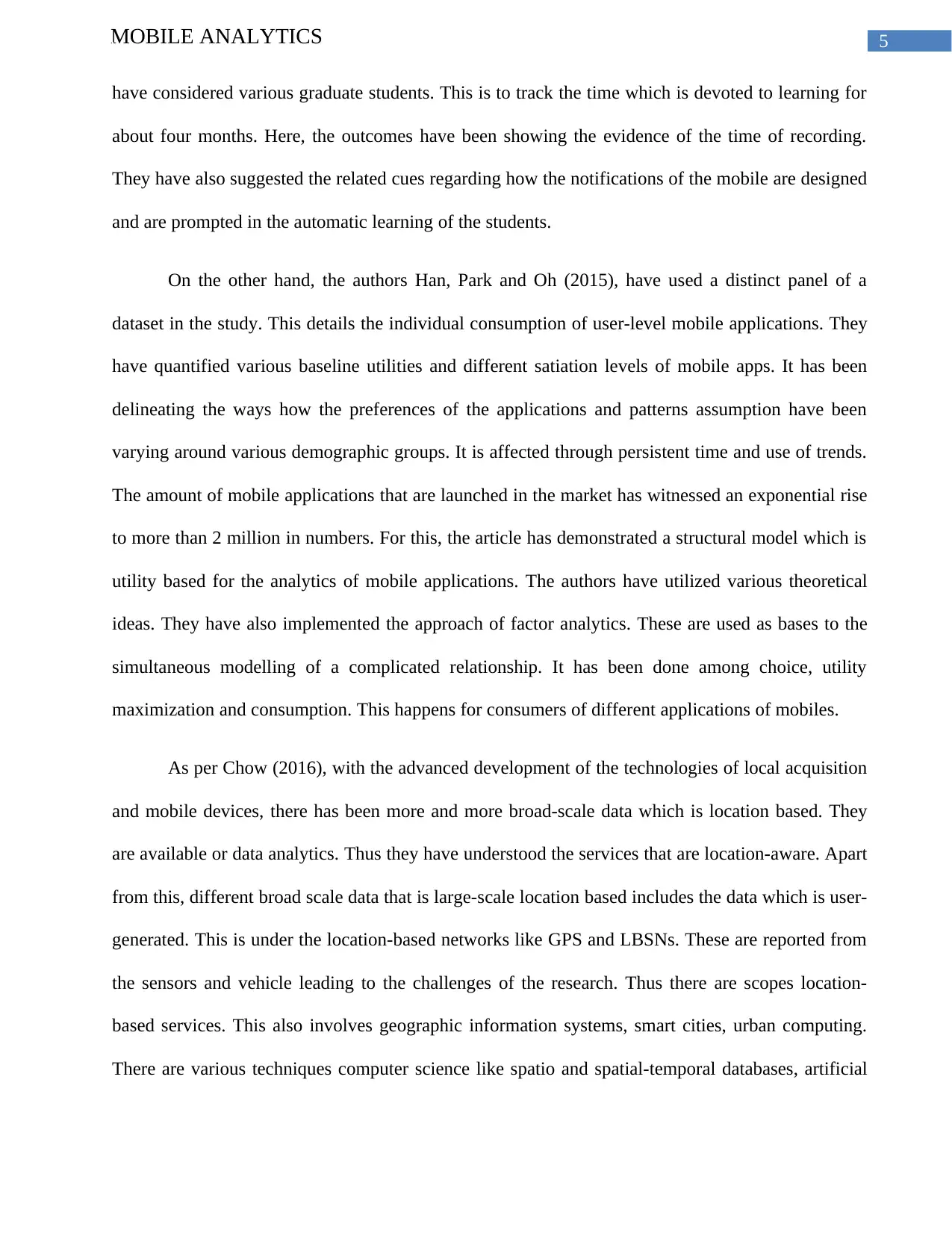
5MOBILE ANALYTICS
have considered various graduate students. This is to track the time which is devoted to learning for
about four months. Here, the outcomes have been showing the evidence of the time of recording.
They have also suggested the related cues regarding how the notifications of the mobile are designed
and are prompted in the automatic learning of the students.
On the other hand, the authors Han, Park and Oh (2015), have used a distinct panel of a
dataset in the study. This details the individual consumption of user-level mobile applications. They
have quantified various baseline utilities and different satiation levels of mobile apps. It has been
delineating the ways how the preferences of the applications and patterns assumption have been
varying around various demographic groups. It is affected through persistent time and use of trends.
The amount of mobile applications that are launched in the market has witnessed an exponential rise
to more than 2 million in numbers. For this, the article has demonstrated a structural model which is
utility based for the analytics of mobile applications. The authors have utilized various theoretical
ideas. They have also implemented the approach of factor analytics. These are used as bases to the
simultaneous modelling of a complicated relationship. It has been done among choice, utility
maximization and consumption. This happens for consumers of different applications of mobiles.
As per Chow (2016), with the advanced development of the technologies of local acquisition
and mobile devices, there has been more and more broad-scale data which is location based. They
are available or data analytics. Thus they have understood the services that are location-aware. Apart
from this, different broad scale data that is large-scale location based includes the data which is user-
generated. This is under the location-based networks like GPS and LBSNs. These are reported from
the sensors and vehicle leading to the challenges of the research. Thus there are scopes location-
based services. This also involves geographic information systems, smart cities, urban computing.
There are various techniques computer science like spatio and spatial-temporal databases, artificial
have considered various graduate students. This is to track the time which is devoted to learning for
about four months. Here, the outcomes have been showing the evidence of the time of recording.
They have also suggested the related cues regarding how the notifications of the mobile are designed
and are prompted in the automatic learning of the students.
On the other hand, the authors Han, Park and Oh (2015), have used a distinct panel of a
dataset in the study. This details the individual consumption of user-level mobile applications. They
have quantified various baseline utilities and different satiation levels of mobile apps. It has been
delineating the ways how the preferences of the applications and patterns assumption have been
varying around various demographic groups. It is affected through persistent time and use of trends.
The amount of mobile applications that are launched in the market has witnessed an exponential rise
to more than 2 million in numbers. For this, the article has demonstrated a structural model which is
utility based for the analytics of mobile applications. The authors have utilized various theoretical
ideas. They have also implemented the approach of factor analytics. These are used as bases to the
simultaneous modelling of a complicated relationship. It has been done among choice, utility
maximization and consumption. This happens for consumers of different applications of mobiles.
As per Chow (2016), with the advanced development of the technologies of local acquisition
and mobile devices, there has been more and more broad-scale data which is location based. They
are available or data analytics. Thus they have understood the services that are location-aware. Apart
from this, different broad scale data that is large-scale location based includes the data which is user-
generated. This is under the location-based networks like GPS and LBSNs. These are reported from
the sensors and vehicle leading to the challenges of the research. Thus there are scopes location-
based services. This also involves geographic information systems, smart cities, urban computing.
There are various techniques computer science like spatio and spatial-temporal databases, artificial
⊘ This is a preview!⊘
Do you want full access?
Subscribe today to unlock all pages.

Trusted by 1+ million students worldwide
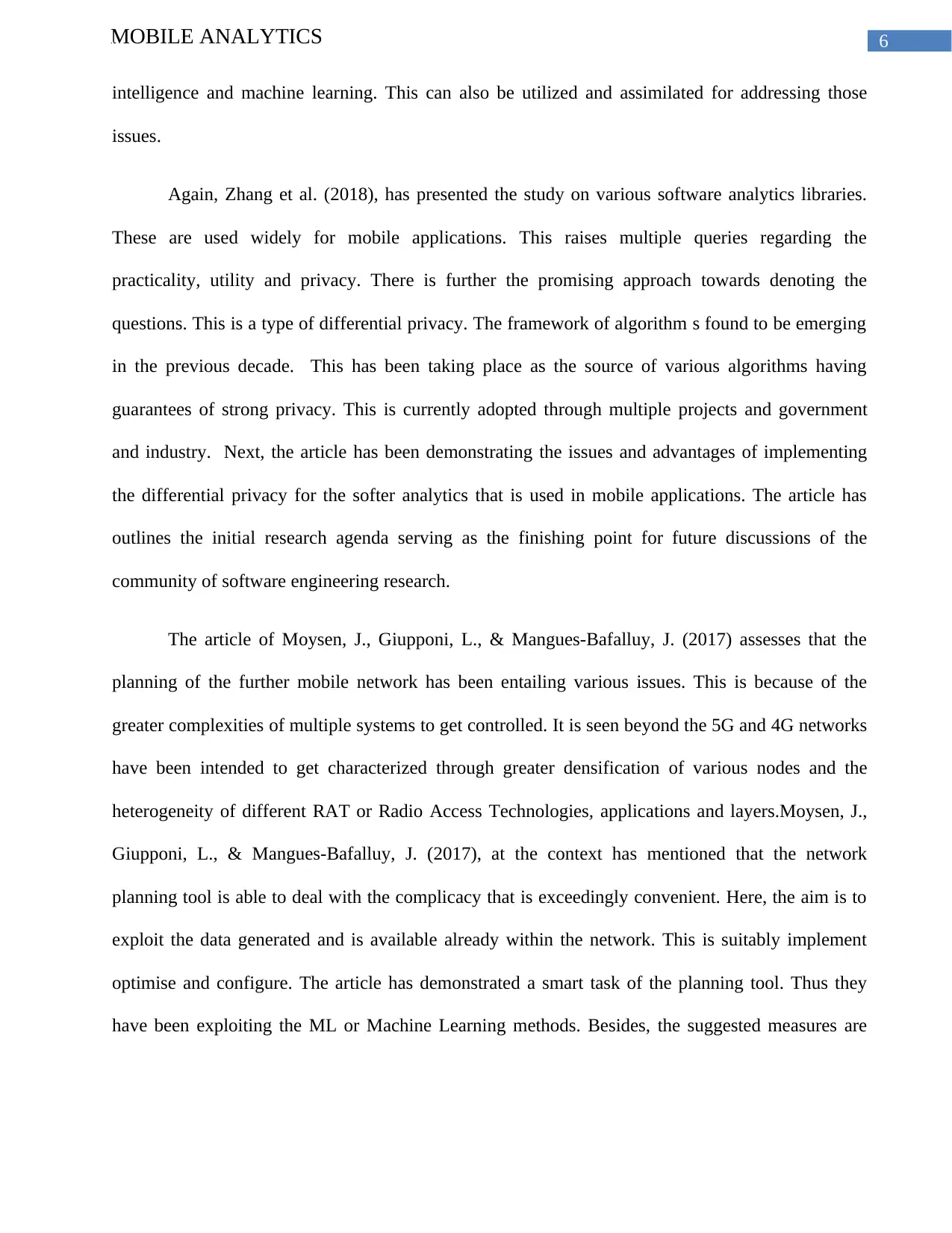
6MOBILE ANALYTICS
intelligence and machine learning. This can also be utilized and assimilated for addressing those
issues.
Again, Zhang et al. (2018), has presented the study on various software analytics libraries.
These are used widely for mobile applications. This raises multiple queries regarding the
practicality, utility and privacy. There is further the promising approach towards denoting the
questions. This is a type of differential privacy. The framework of algorithm s found to be emerging
in the previous decade. This has been taking place as the source of various algorithms having
guarantees of strong privacy. This is currently adopted through multiple projects and government
and industry. Next, the article has been demonstrating the issues and advantages of implementing
the differential privacy for the softer analytics that is used in mobile applications. The article has
outlines the initial research agenda serving as the finishing point for future discussions of the
community of software engineering research.
The article of Moysen, J., Giupponi, L., & Mangues-Bafalluy, J. (2017) assesses that the
planning of the further mobile network has been entailing various issues. This is because of the
greater complexities of multiple systems to get controlled. It is seen beyond the 5G and 4G networks
have been intended to get characterized through greater densification of various nodes and the
heterogeneity of different RAT or Radio Access Technologies, applications and layers.Moysen, J.,
Giupponi, L., & Mangues-Bafalluy, J. (2017), at the context has mentioned that the network
planning tool is able to deal with the complicacy that is exceedingly convenient. Here, the aim is to
exploit the data generated and is available already within the network. This is suitably implement
optimise and configure. The article has demonstrated a smart task of the planning tool. Thus they
have been exploiting the ML or Machine Learning methods. Besides, the suggested measures are
intelligence and machine learning. This can also be utilized and assimilated for addressing those
issues.
Again, Zhang et al. (2018), has presented the study on various software analytics libraries.
These are used widely for mobile applications. This raises multiple queries regarding the
practicality, utility and privacy. There is further the promising approach towards denoting the
questions. This is a type of differential privacy. The framework of algorithm s found to be emerging
in the previous decade. This has been taking place as the source of various algorithms having
guarantees of strong privacy. This is currently adopted through multiple projects and government
and industry. Next, the article has been demonstrating the issues and advantages of implementing
the differential privacy for the softer analytics that is used in mobile applications. The article has
outlines the initial research agenda serving as the finishing point for future discussions of the
community of software engineering research.
The article of Moysen, J., Giupponi, L., & Mangues-Bafalluy, J. (2017) assesses that the
planning of the further mobile network has been entailing various issues. This is because of the
greater complexities of multiple systems to get controlled. It is seen beyond the 5G and 4G networks
have been intended to get characterized through greater densification of various nodes and the
heterogeneity of different RAT or Radio Access Technologies, applications and layers.Moysen, J.,
Giupponi, L., & Mangues-Bafalluy, J. (2017), at the context has mentioned that the network
planning tool is able to deal with the complicacy that is exceedingly convenient. Here, the aim is to
exploit the data generated and is available already within the network. This is suitably implement
optimise and configure. The article has demonstrated a smart task of the planning tool. Thus they
have been exploiting the ML or Machine Learning methods. Besides, the suggested measures are
Paraphrase This Document
Need a fresh take? Get an instant paraphrase of this document with our AI Paraphraser
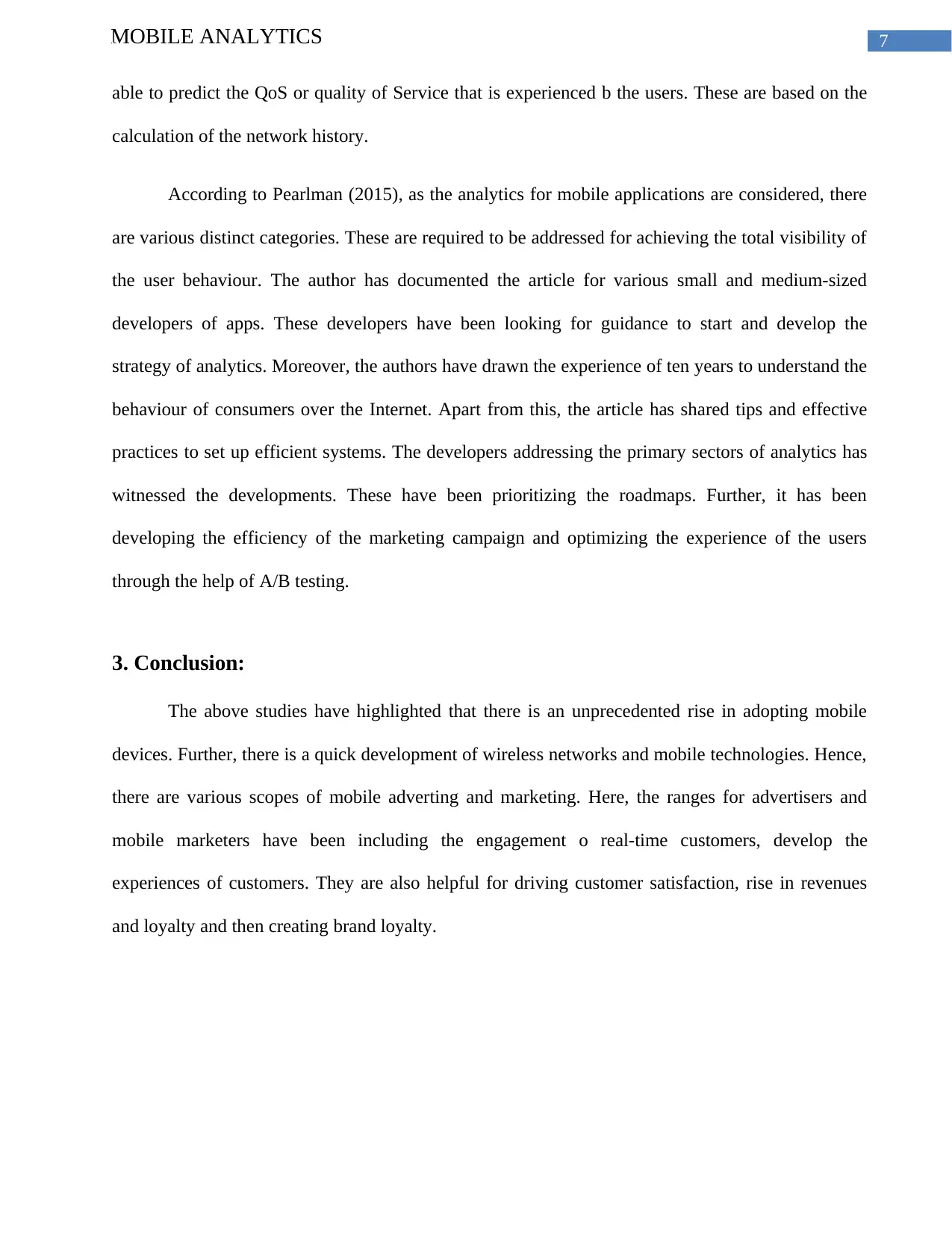
7MOBILE ANALYTICS
able to predict the QoS or quality of Service that is experienced b the users. These are based on the
calculation of the network history.
According to Pearlman (2015), as the analytics for mobile applications are considered, there
are various distinct categories. These are required to be addressed for achieving the total visibility of
the user behaviour. The author has documented the article for various small and medium-sized
developers of apps. These developers have been looking for guidance to start and develop the
strategy of analytics. Moreover, the authors have drawn the experience of ten years to understand the
behaviour of consumers over the Internet. Apart from this, the article has shared tips and effective
practices to set up efficient systems. The developers addressing the primary sectors of analytics has
witnessed the developments. These have been prioritizing the roadmaps. Further, it has been
developing the efficiency of the marketing campaign and optimizing the experience of the users
through the help of A/B testing.
3. Conclusion:
The above studies have highlighted that there is an unprecedented rise in adopting mobile
devices. Further, there is a quick development of wireless networks and mobile technologies. Hence,
there are various scopes of mobile adverting and marketing. Here, the ranges for advertisers and
mobile marketers have been including the engagement o real-time customers, develop the
experiences of customers. They are also helpful for driving customer satisfaction, rise in revenues
and loyalty and then creating brand loyalty.
able to predict the QoS or quality of Service that is experienced b the users. These are based on the
calculation of the network history.
According to Pearlman (2015), as the analytics for mobile applications are considered, there
are various distinct categories. These are required to be addressed for achieving the total visibility of
the user behaviour. The author has documented the article for various small and medium-sized
developers of apps. These developers have been looking for guidance to start and develop the
strategy of analytics. Moreover, the authors have drawn the experience of ten years to understand the
behaviour of consumers over the Internet. Apart from this, the article has shared tips and effective
practices to set up efficient systems. The developers addressing the primary sectors of analytics has
witnessed the developments. These have been prioritizing the roadmaps. Further, it has been
developing the efficiency of the marketing campaign and optimizing the experience of the users
through the help of A/B testing.
3. Conclusion:
The above studies have highlighted that there is an unprecedented rise in adopting mobile
devices. Further, there is a quick development of wireless networks and mobile technologies. Hence,
there are various scopes of mobile adverting and marketing. Here, the ranges for advertisers and
mobile marketers have been including the engagement o real-time customers, develop the
experiences of customers. They are also helpful for driving customer satisfaction, rise in revenues
and loyalty and then creating brand loyalty.
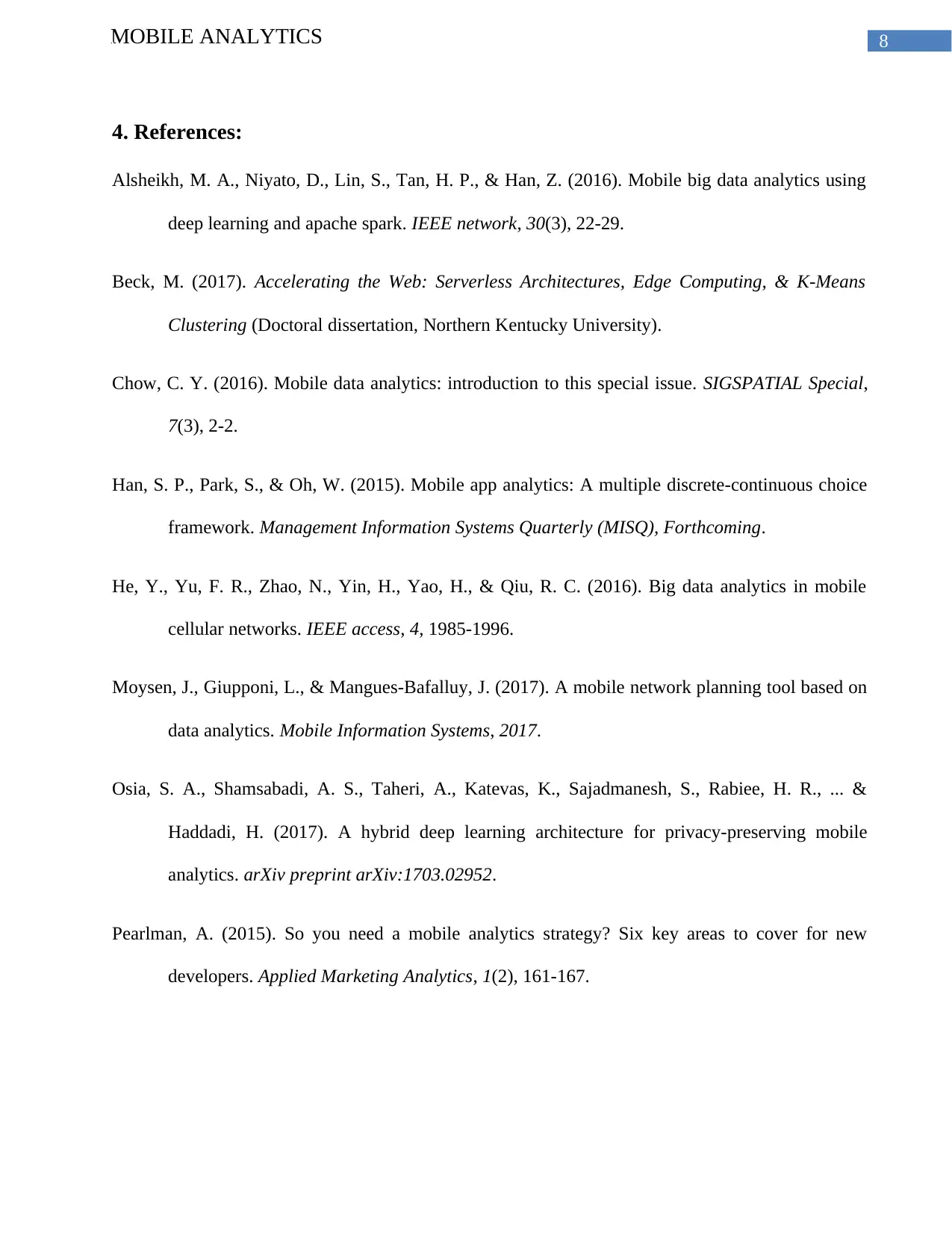
8MOBILE ANALYTICS
4. References:
Alsheikh, M. A., Niyato, D., Lin, S., Tan, H. P., & Han, Z. (2016). Mobile big data analytics using
deep learning and apache spark. IEEE network, 30(3), 22-29.
Beck, M. (2017). Accelerating the Web: Serverless Architectures, Edge Computing, & K-Means
Clustering (Doctoral dissertation, Northern Kentucky University).
Chow, C. Y. (2016). Mobile data analytics: introduction to this special issue. SIGSPATIAL Special,
7(3), 2-2.
Han, S. P., Park, S., & Oh, W. (2015). Mobile app analytics: A multiple discrete-continuous choice
framework. Management Information Systems Quarterly (MISQ), Forthcoming.
He, Y., Yu, F. R., Zhao, N., Yin, H., Yao, H., & Qiu, R. C. (2016). Big data analytics in mobile
cellular networks. IEEE access, 4, 1985-1996.
Moysen, J., Giupponi, L., & Mangues-Bafalluy, J. (2017). A mobile network planning tool based on
data analytics. Mobile Information Systems, 2017.
Osia, S. A., Shamsabadi, A. S., Taheri, A., Katevas, K., Sajadmanesh, S., Rabiee, H. R., ... &
Haddadi, H. (2017). A hybrid deep learning architecture for privacy-preserving mobile
analytics. arXiv preprint arXiv:1703.02952.
Pearlman, A. (2015). So you need a mobile analytics strategy? Six key areas to cover for new
developers. Applied Marketing Analytics, 1(2), 161-167.
4. References:
Alsheikh, M. A., Niyato, D., Lin, S., Tan, H. P., & Han, Z. (2016). Mobile big data analytics using
deep learning and apache spark. IEEE network, 30(3), 22-29.
Beck, M. (2017). Accelerating the Web: Serverless Architectures, Edge Computing, & K-Means
Clustering (Doctoral dissertation, Northern Kentucky University).
Chow, C. Y. (2016). Mobile data analytics: introduction to this special issue. SIGSPATIAL Special,
7(3), 2-2.
Han, S. P., Park, S., & Oh, W. (2015). Mobile app analytics: A multiple discrete-continuous choice
framework. Management Information Systems Quarterly (MISQ), Forthcoming.
He, Y., Yu, F. R., Zhao, N., Yin, H., Yao, H., & Qiu, R. C. (2016). Big data analytics in mobile
cellular networks. IEEE access, 4, 1985-1996.
Moysen, J., Giupponi, L., & Mangues-Bafalluy, J. (2017). A mobile network planning tool based on
data analytics. Mobile Information Systems, 2017.
Osia, S. A., Shamsabadi, A. S., Taheri, A., Katevas, K., Sajadmanesh, S., Rabiee, H. R., ... &
Haddadi, H. (2017). A hybrid deep learning architecture for privacy-preserving mobile
analytics. arXiv preprint arXiv:1703.02952.
Pearlman, A. (2015). So you need a mobile analytics strategy? Six key areas to cover for new
developers. Applied Marketing Analytics, 1(2), 161-167.
⊘ This is a preview!⊘
Do you want full access?
Subscribe today to unlock all pages.

Trusted by 1+ million students worldwide
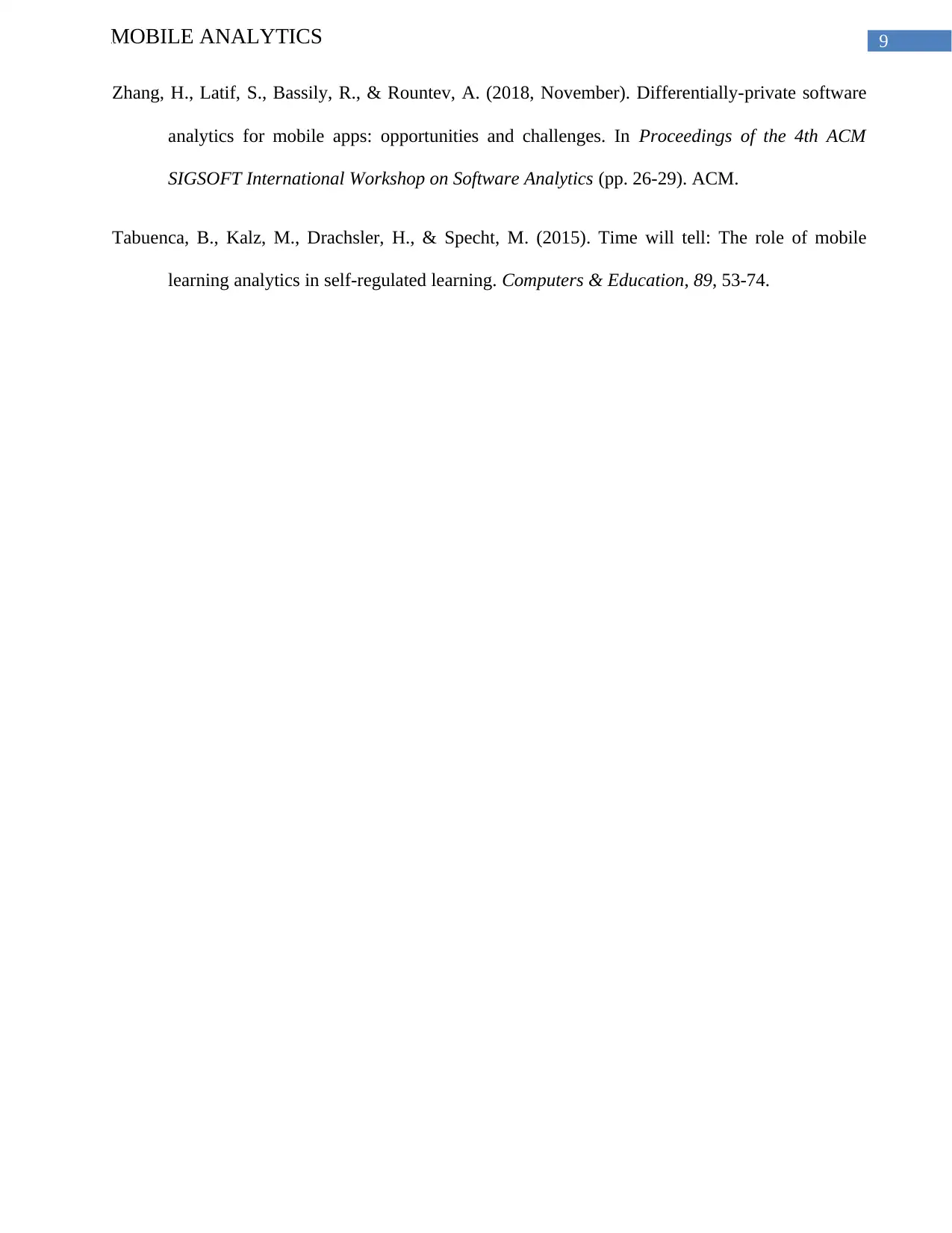
9MOBILE ANALYTICS
Zhang, H., Latif, S., Bassily, R., & Rountev, A. (2018, November). Differentially-private software
analytics for mobile apps: opportunities and challenges. In Proceedings of the 4th ACM
SIGSOFT International Workshop on Software Analytics (pp. 26-29). ACM.
Tabuenca, B., Kalz, M., Drachsler, H., & Specht, M. (2015). Time will tell: The role of mobile
learning analytics in self-regulated learning. Computers & Education, 89, 53-74.
Zhang, H., Latif, S., Bassily, R., & Rountev, A. (2018, November). Differentially-private software
analytics for mobile apps: opportunities and challenges. In Proceedings of the 4th ACM
SIGSOFT International Workshop on Software Analytics (pp. 26-29). ACM.
Tabuenca, B., Kalz, M., Drachsler, H., & Specht, M. (2015). Time will tell: The role of mobile
learning analytics in self-regulated learning. Computers & Education, 89, 53-74.
1 out of 10
Related Documents
Your All-in-One AI-Powered Toolkit for Academic Success.
+13062052269
info@desklib.com
Available 24*7 on WhatsApp / Email
![[object Object]](/_next/static/media/star-bottom.7253800d.svg)
Unlock your academic potential
Copyright © 2020–2025 A2Z Services. All Rights Reserved. Developed and managed by ZUCOL.




